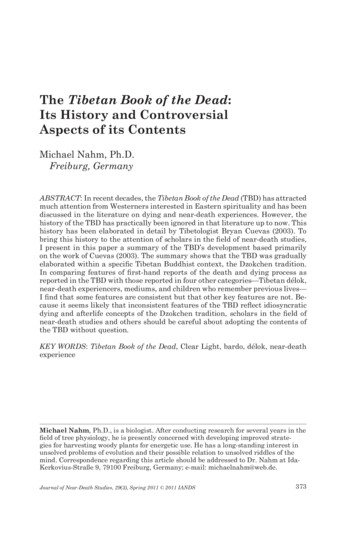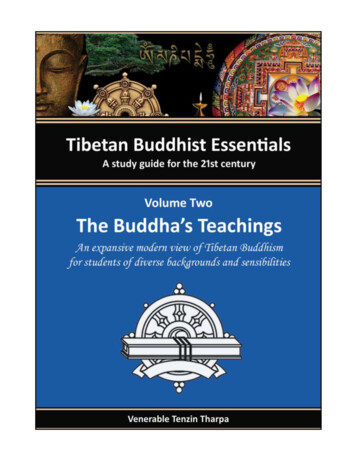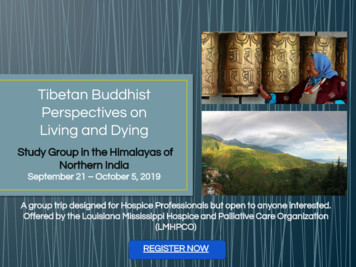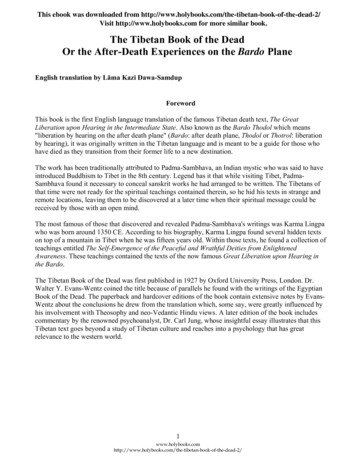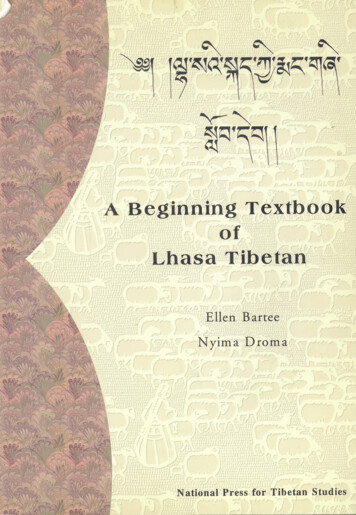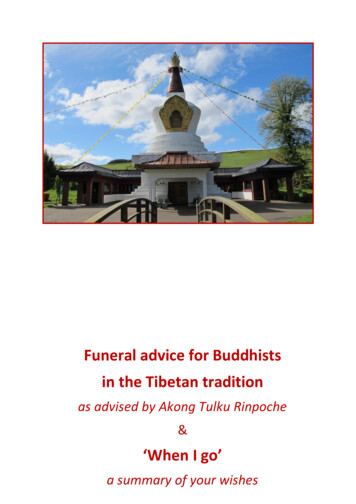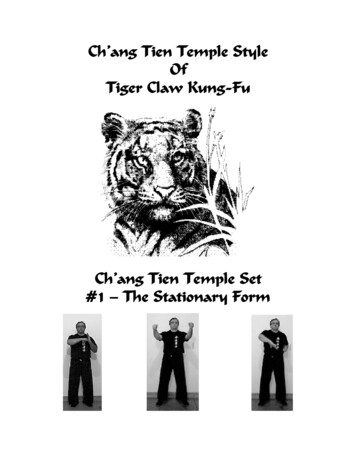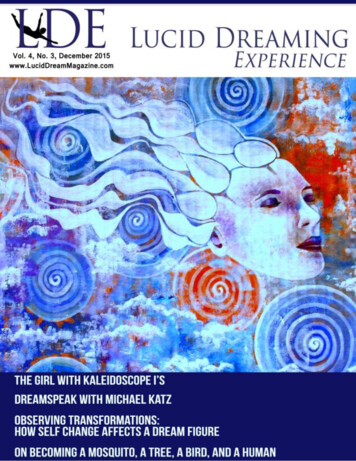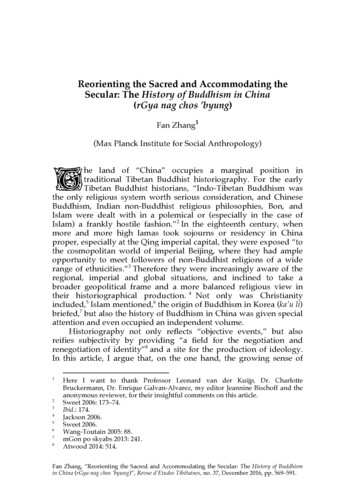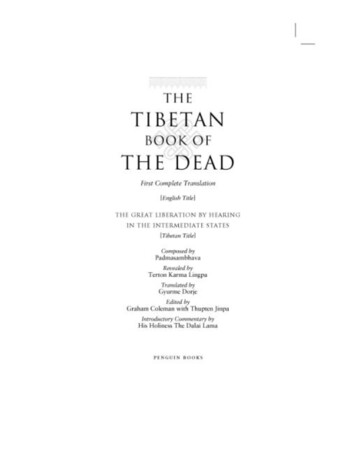
Transcription
Table of ContentsTitle PageCopyright PageAcknowledgementsIntroductionChapter 1 - Natural Liberation of the Nature of Mind: The Four-session Yoga .Chapter 2 - A Prayer for Union with the Spiritual Teacher, [entitled] Natural .Chapter 3 - Root Verses of the Six Intermediate StatesChapter 4 - The Introduction to Awareness: Natural Liberation through NakedPerceptionChapter 5 - The Spiritual Practice entitled Natural Liberation of HabitualTendenciesChapter 6 - Natural Liberation of Negativity and Obscuration through .Chapter 7 - Natural Liberation through Acts of ConfessionChapter 8 - Natural Liberation through Recognition of the Visual Indications .Chapter 9 - Natural Liberation of Fear through the Ritual Deception of DeathChapter 10 - Consciousness Transference: Natural Liberation throughRecollectionChapter 11 - The Great Liberation by HearingChapter 12 - Aspirational PrayersChapter 13 - A Masked Drama of RebirthChapter 14 - Liberation by Wearing: Natural Liberation of the Psycho-physicalAggregatesAppendix One: Peaceful and Wrathful Deities and the Tibetan Book of the DeadAppendix Two: Symbolism of the Maṇḍala of the Peaceful and Wrathful DeitiesNotesBibliographyGlossary of Key TermsThematic Index by ChapterFOR THE BEST IN PAPERBACKS, LOOK FOR THE
PENGUIN CLASSICS DELUXE EDITIONTHE TIBETAN BOOK OF THE DEADThe translation of The Tibetan Book of the Dead was carried out with the supportof His Holiness the Dalai Lama and with the commentarial guidance of reveredcontemporary Tibetan masters including the late Head of the Nyingma School ofTibetan Buddhism HH Dilgo Khyentse Rinpoche, Zenkar Rinpoche and GarjeKhamtrul Rinpoche.GYURME DORJE (PhD) is a leading scholar of the Nyingma tradition ofTibetan Buddhism. His seven major publications include works on Tibetanlexicography, medicine, divination and pilgrimage guides to Tibet and Bhutan,as well as the translations of HH Dudjom Rinpoche’s The Nyingma School ofTibetan Buddhism. His forthcoming titles include The Guhyagarbha Tantra:Dispelling the Darkness of the Ten Directions.GRAHAM COLEMAN is President of the Orient Foundation (UK), a majorTibetan cultural conservancy organization. Writer/director of the acclaimedfeature documentary Tibet: A Buddhist Trilogy and editor of the Handbook ofTibetan Culture, he has been editing Tibetan Buddhist poetry and prose texts incooperation with various distinguished translators since the mid -1970s.THUPTEN JINPA (PhD) is the senior translator to His Holiness the Dalai Lamaand President of the Institute of Tibetan Classics. His works include thetranslation of twelve books by the Dalai Lama, including the New York Timesbestseller Ethics for the New Millennium and the forthcoming The Universe in aSingle Atom, the Dalai Lama’s perspective on the meeting of Buddhism andmodern science.
Padmasambhava (Guru Rinpoche)
Padmasambhava (Guru Rinpoche)
PENGUIN BOOKSPublished by the Penguin GroupPenguin Group (USA) Inc., 375 Hudson Street,New York, New York 10014, U.S.A.Penguin Group (Canada), 90 Eglinton Avenue East, Suite 700, Toronto, Ontario,Canada M4P 2Y3 (a division of Pearson Penguin Canada Inc.)Penguin Books Ltd, 80 Strand, London WC2R 0RL, EnglandPenguin Ireland, 25 St Stephen’s Green, Dublin 2,Ireland (a division of Penguin Books Ltd)Penguin Group (Australia), 250 Camberwell Road, Camberwell, Victoria 3124,Australia (a division of Pearson Australia Group Pty Ltd)Penguin Books India Pvt Ltd, 11 Community Centre,Panchsheel Park, New Delhi - 110 017, IndiaPenguin Group (NZ), 67 Apollo Drive, Mairangi Bay, Auckland 1310, New Zealand(a division of Pearson New Zealand Ltd)Penguin Books (South Africa) (Pty) Ltd, 24 Sturdee Avenue,Rosebank, Johannesburg 2196, South AfricaPenguin Books Ltd, Registered Offices:80 Strand, London WC2R 0RL, EnglandFirst published in Great Britain by Penguin Books Ltd 2005First published in the United States of America by Viking Penguin,a member of Penguin Group (USA) Inc. 2006Published in Penguin Books (UK) 2006Published in Penguin Books (USA) 2007Translation copyright The Orient Foundation (UK) and Gyurme Dorje, 2005 Editorial apparatuscopyright The Orient Foundation (UK), Graham Coleman, and Thupten Jinpa, 2005 Introductorycommentary copyright His Holiness The Dalai Lama, 2005All rights reservedThangkas painted by the late Shawu Tsering of Repkong and photographed by Jill Morley Smith are fromthe private collection of Gyurme Dorje.eISBN : 978-1-101-46228-7CIP data availableThe scanning, uploading and distribution of this book via the Internet or via any other means without thepermission of the publisher is illegal and punishable by law. Please purchase only authorized electroniceditions, and do not participate in or encourage electronic piracy of copyrighted materials. Your support ofthe author’s rights is appreciated.
http://us.penguingroup.com
May all sentient beings,children of buddha nature,realisethe ultimate nature of mind:insight and compassion,in blissful union.
AcknowledgementsOur project began in 1988 when HH the Dalai Lama kindly offered to requestHH Dilgo Khyentse Rinpoche, the late head of the Nyingma school, to give anoral commentary to me on key sections of the Tibetan Book of the Dead. TheDalai Lama knew that various translations had been made of ‘The GreatLiberation by Hearing’, our Chapter 11, but that so far no one had translated theentire Tibetan Book of the Dead. HH Dilgo Khyentse graciously agreed to theDalai Lama’s request and over a period of four weeks gave the empowermentsand an incisive and illuminating oral commentary to the core elements of thetext, which was eloquently translated each day by Sogyal Rinpoche.While in Kathmandu, receiving the oral commentary from HH DilgoKhyentse Rinpoche, I had the good fortune to meet Dr Gyurme Dorje, who hadpreviously translated Longchen Rabjampa’s commentary to the GuhygarbhaTantra, the root text on which the Tibetan Book of the Dead is based. During ourfirst meeting, Gyurme agreed to make a new annotated translation of the entireTibetan Book of the Dead, a task he undertook with exceptional care anddedication over the years that followed. While Gyurme was working on thetranslation he was also employed at the School of Oriental and African Studiesin London as a research fellow, translating into English the Greater TibetanChinese Dictionary (Bod-rgya tshig-mdzod chen-mo). During this time, Gyurmeworked closely with the highly regarded Nyingma master Zenkar Rinpoche, whois one of the foremost contemporary lineage holders of the Tibetan Book of theDead. Zenkar Rinpoche kindly advised Gyurme throughout the translation of ourtext and also gave an extensive oral commentary to us on Chapter 4, ‘TheIntroduction to Awareness’.At various stages of the project, the Dalai Lama answered my questions aboutdifficult points, and he also dictated to me the lucid and succinct IntroductoryCommentary. At the Dalai Lama’s request, Khamtrul Rinpoche, an adviser to theDalai Lama on Nyingma studies, also gave a beautiful oral commentary to keysections of Chapter 8 and dictated the introduction to Chapter 11.Throughout the editing process I had the happy good fortune of working withGeshe Thupten Jinpa, senior translator to the Dalai Lama, whom I had first metin 1977 and who has been a close friend since he came to England to study
philosophy at Cambridge in 1989. Jinpa translated the Dalai Lama’sIntroductory Commentary and reviewed every line and word of all fourteenchapters of the edited translation with me twice, in the course of which he madecountless important and inspiring suggestions. Everyone who knows Jinpa’swork is aware of his special talent and skill both as a translator and writer andthese have played an invaluable role in this project. Finally, the individualintroductions to each of the chapters, except Chapter 11, were written by DashoSangay Dorji, a Bhutanese scholar, who comes from a family whose paternalline has been lineage holders of the Tibetan Book of the Dead for severalgenerations and who throughout his childhood accompanied his father everytime he was called to a household to carry out these practices.Needless to say it has been a wonderful privilege for us to work with all thosewho helped to make this project possible. Our insights and skills as writerswould not even register on the most sensitive of detectors compared to those ofthe composers of the original cycle of teachings or the lineage holders who gavethe commentarial explanation that guided us. Throughout this endeavourtherefore we have tried to substitute hard work and attention to detail for ourlack of ability and to let the original magnificence of the text shine through theclouds of our shortcomings as much as we were able.My work on this project would not have been possible without the life-longfriendship of the Orient Foundation’s chairman David Lascelles. It is difficult tothank him enough for all that he has made possible, beginning with our worktogether on the making of our films Tibet: A Buddhist Trilogy, in the 1970s, andever since. Two other special friends, Elinore Detiger and Elsie Walker made itpossible for this project to be initiated, and their kindness and confidence,together with that of Michael Baldwin, will never be forgotten. My sincereappreciation goes also to Johnnie and Buff Chace, Lucinda Ziesing, Faith Bieler,Lavinia Currier, Cynthia Jurs, Catherine Cochran, Margot Wilkie, Basil Panzer,Bokara Patterson and Lindsay Masters for their important contributions in theearly stages of this work.At Gyurme Dorje’s request, Gene Smith of the Tibetan Buddhist ResourceCenter in New York generously made available a digital version of the threevolume manuscript from the library of the late Kyabje Dudjom Rinpoche, onwhich our translation is largely based. HH Dilgo Khyentse Rinpoche hadpreviously provided copies of the text reprinted under his supervision in Delhi.Other versions of the text which we consulted, including the Varanasi reprintand other versions of Bhutanese and Chinese origin, are all from Gyurme
Dorje’s private collection. Some source materials were also kindly provided byZenkar Rinpoche, Tulku Jigme Khyentse, Dr Burkhard Quessel of the BritishLibrary, and Dr Fernand Meyer of CNRS in Paris. Gyurme Dorje also especiallyacknowledges the kindness and profound advice of all of his teachers within theNyingma tradition, including the previous Kangyur, Dudjom and DilgoKhyentse Rinpoches, as well as Tulku Pema Wangyal and Zenkar Rinpoche, andhe thanks his wife Xiaohong for all her encouragement and sustenance duringthe final years of this project.I am very grateful to Gillon Aitken, my agent, for introducing this project toPenguin, our publishers, and to Simon Winder, our editor at Penguin, for hispatience and unfailing enthusiasm during the long genesis of this work. Ourthanks go also to Dr Martin Boord and Andrew Bell for their proofreading of thetext and to Robert Chilton for compiling the thematic index.GRAHAM COLEMANBath, England
Acknowledgements for the IllustrationsThe colour illustrations that appear in our text have never previously beenpublished. The two painted scrolls depicting the Hundred Peaceful and WrathfulDeities in Repkong style, which were commissioned by Gyurme Dorje in 2002,are from the studio of the late master artist Shawu Tsering of SengeshongYagotsang in Amdo.The line drawings of Guru Padmasambhava (p. iv) and Karma Lingpa (p. xlvi)are the work of Robert Beer. The circular chart of mantras (btags-grol) (p. 346)is reproduced from Fremantle and Trungpa, The Tibetan Book of the Dead(Shambhala Classics, 2000), p. 32.
Introductory Commentaryby His Holiness the XIVth Dalai LamaThe question of whether or not there exists a continuity of consciousness afterdeath has been an important aspect of philosophical reflection and debate fromancient Indian times to the present. When considering these matters from aBuddhist point of view, however, we have to bear in mind that the understandingof the nature of continuity of consciousness and the understanding of the natureof the ‘I’ or ‘self’ are closely interlinked. Therefore, let us first look at what it isthat can be said to constitute a person.According to Buddhist classical literature, a person can be seen as possessingfive interrelated aggregates, technically known as the five psycho-physicalaggregates.a These are the aggregate of consciousness, the aggregate of form(which includes our physical body and senses), the aggregate of feeling, theaggregate of discrimination, and the aggregate of motivational tendencies. Thatis to say, there is our body, the physical world and our five senses, and there arethe various processes of mental activity, our motivational tendencies, ourlabelling of and discrimination between objects, our feelings, and the underlyingawareness or consciousness.Among the ancient schools of thought, which accepted the notion ofcontinuity of consciousness, there were several non-Buddhist philosophicalschools which regarded the entity, the ‘I’ or ‘self’, which migrated fromexistence to existence as being unitary and permanent. They also suggested thatthis ‘self’ was autonomous in its relationship to the psycho-physical componentsthat constitute a person. In other words they believed or posited that there is anessence or ‘soul’ of the person, which exists independently from the body andthe mind of the person.However, Buddhist philosophy does not accept the existence of such anindependent, autonomous entity. In the Buddhist view, the self or the person isunderstood in terms of a dynamic interdependent relationship of both mental andphysical attributes, that is to say the psycho-physical components which
constitute a person. In other words our sense of self can, upon examination, beseen as a complex flow of mental and physical events, clustered in clearlyidentifiable patterns, including our physical features, instincts, emotions, andattitudes, etc., continuing through time. Further, according to PrāsaṅgikaMadhyamaka philosophy, which has become the prevailing philosophical viewof Tibetan Buddhism today, this sense of self is simply a mental construct, amere label given to this cluster of dependently arising mental and physicalevents in dependence on their continuity.Now, when we look at this interdependence of mental and physicalconstituents from the perspective of Highest Yoga Tantra,b there are twoconcepts of a person. One is the temporary person or self, that is as we exist atthe moment, and this is labelled on the basis of our coarse or gross physical bodyand conditioned mind, and, at the same time, there is a subtle person or selfwhich is designated in dependence on the subtle body and subtle mind. Thissubtle body and subtle mind are seen as a single entity that has two facets. Theaspect which has the quality of awareness, which can reflect and has the powerof cognition, is the subtle mind. Simultaneously, there is its energy, the forcethat activates the mind towards its object - this is the subtle body or subtle wind.These two inextricably conjoined qualities are regarded, in Highest Yoga Tantra,as the ultimate nature of a person and are identified as buddha nature, theessential or actual nature of mind.Now, before we look more closely at the nature of the subtle body and mind,let us look at how the gross body and mind are thought to originate. The notionof dependent origination lies at the very heart of Buddhist philosophy. Theprinciple of dependent origination asserts that nothing exists in its own rightindependent of other factors. Things and events come into being only independence on the aggregation of multiple causes and conditions. The processthrough which the external world and the sentient beings within it revolve in acycle of existence propelled by karmic propensities and their interaction withmisapprehension, attraction and aversion and conditions is described in terms oftwelve interdependent links. Each cycle of the process begins with amisapprehension of the nature of actual reality. This fundamental ignorance actsas a condition for the arising of the propensities created by our past actions,mental, verbal and physical, which condition our dualising consciousness. Ourdualising consciousness, in turn, conditions the qualities and mode of interactionof our psycho-physical aggregates, which condition our sensory fields, whichgenerate contact, which generates sensations, and then in turn attachment,
grasping, and maturation towards rebirth. At this point there is an interactionwith the genetic constituents of the parents and subsequent interaction with theenvironment, and then finally we have birth, ageing and death. This cycle can beviewed as both illustrating the underlying processes of life, death and rebirth andas an illustration of the processes to be transformed on the path to liberationfrom suffering in cyclic existence.The notion that there is a connection between this life and the events of bothour previous existence and our future existence, follows from the Buddhistunderstanding of the natural law of cause and effect. For example, although wecan speak of yesterday’s weather and today’s weather as distinct, today’sweather is inextricably linked with the weather patterns of yesterday. Even at thebodily level, in the case of our physical health for example, we know that eventsin the past affect the present and those of the present the future. Similarly, in therealm of consciousness the Buddhist view is that there is also this same causalcontinuum between the events of the past, present and future.The Buddhist understanding of the continuity of personal experience,including our memories, can also be considered here. The Buddhist view is thatthe continuity of personal experience is primarily founded on the capacity forretention, which can be further developed during one’s meditative practice inthis life. However, generally speaking, it is thought that if a person dies after aprolonged period of illness that has led to a prolonged degeneration of bothphysical and mental capacities, there will be a greater chance of many of thepersonal characteristics, including memories etc., being lost. On the other hand,in the case of someone who dies a sudden death, when the mind-bodyrelationship at the gross level is still very firm, it is thought that there is a greaterchance of carrying forward the acquired characteristics and memories, etc.Nonetheless, in both cases, the characteristics carried forward from a previouslife are generally thought to be most strongly felt at an early stage of one’srebirth. This is because the personal characteristics of the previous life arethought, generally speaking, to be quickly overwhelmed by the developingcharacteristics inherited from the parents of the present life. Nonetheless, as Ihave mentioned, much depends in this respect on the individual’s capacity forrecall and this capacity for recall is dependent on a deepened retentive trainingacquired in this lifetime.Now, let us look at the possible states of existence one can be born into. Fromthe Buddhist perspective, rebirth in conditioned existence can take place in oneof three realms: the formless realm, the form realm or the desire realm. The form
and formless realms are fruits of subtle states of consciousness, attained upon therealisation of certain meditative concentrations. Our realm, the desire realm, isthe most gross of these three. Six classes of beings are described as inhabitingthe desire realm: gods (mundane celestial beings whose primary mental state isexaltation), antigods (who are predominantly hostile and jealous), human beings(who are influenced by all the five dissonant mental states), animals (who areunder the sway of delusion), anguished spirits (who are under the sway ofattachment and unsatisfied craving) and hell beings (who are overwhelmed byhatred, anger and fear). In the literature of Highest Yoga Tantra, the evolution ofall the three realms of conditioned existence are described in terms of differingexpressions or states of energy and, as I have mentioned, it is said that ourfundamental ignorance is the root of conditioned existence and that karmicenergy is its activating force. In the Buddhist view, therefore, it is the nature ofour habitual tendencies that generates our future existence, driven by the naturallaw of cause and effect.Further, when we observe the patterns of arising and subsiding that underliethe dynamic nature of the physical environment, the cycle of days and nights andthe passing of the seasons, for example, and we observe how matter arises frominsubstantial subatomic particles and we look at the patterns of causalconnectedness in the arising and dissolution of our mental experiences frommoment to moment, across the differing phases of deep sleep, dreams and ourwaking state, the notion of continuity of consciousness can come to be seen to bein accord with both the nature of our environment and the nature of our mentalexperience. Certainly, it has often been argued that one advantage of acceptingthe notion of continuity of consciousness is that it gives us a more profoundability to understand and to explain the nature of our existence and of theuniverse. In addition, this notion of continuity and causal interconnectednessreinforces a sense of consequences for our own actions, in terms of both theimpact on ourselves and the impact on others and the environment.So, in summary, when considering the notion of continuity of consciousnesswe must bear in mind that there are many different levels of greater or lessersubtlety in the states of consciousness. For example, we know of course thatcertain qualities of sensory perception are dependent on the physical constitutionof the individual and that when the physical body dies, the states ofconsciousness associated with these sensory perceptions also cease. But,although we know that the human body serves as a condition for humanconsciousness, the question still remains: what is the nature of the underlying
factor or essence that accounts for our experience of consciousness as having thenatural quality of luminosity and awareness?Finally, then, when considering the interrelationship between mind, body andthe environment at the subtle level, we know that material things are composedof cells, atoms and particles and that consciousness is composed of moments.That is to say that mind and matter have distinctly different natures and thereforehave different substantial causes. Material things come into being based on othermaterial entities such as particles, atoms and cells and the mind comes into beingbased on a previous moment of mind, which is something that is luminous andhas the capacity to be aware. Each moment of awareness therefore depends on aprevious moment of awareness as its cause. This is the reasoning upon whichBuddhist logic asserts that there is at the level of subtle mind and subtle wind abeginningless continuum of mind and matter.It is through reflection on the above themes: the law of cause and effect,dependent origination, the dynamics of our physical environment, and, based onour analysis of the nature of mind, the mode of the arising and subsiding ofthoughts, the shifts in the modalities of our consciousness between deep sleep,dreams and our waking state, etc., that the notion of continuity of consciousnessmay first become established as relevant to the understanding of our currentcondition. Once the notion of this continuity has been confirmed, throughreflection and experience, then it becomes logical to prepare oneself for deathand for future existences.Now, as to the nature of the actual preparation itself, this will depend on eachindividual’s depth of spiritual aspiration. For example, if an individual is simplyseeking a favourable rebirth as a human being, there is no need to engage in asophisticated meditative path related to the processes of death and rebirth.Simply to live a virtuous life is seen as sufficient. Similarly, in the case of thosewho are seeking personal liberation from conditioned existence and also in thecase of those whose practice is confined to the sūtra level of the Mahāyāna path,their meditative preparation will be limited to ensuring the attainment ofsuccessive forms of existence that will be conducive to the continuation of theirjourney towards enlightenment. For these three kinds of individuals, no actualtechniques for utilising the time of death as an essential element of the spiritualpath have been set down in the classical Buddhist literature. Nevertheless, sincethe understanding of the processes of death, the intermediate state and rebirth arecrucial to our understanding of the nature of existence, we do find extensivediscussion of these three processes, even in the texts which relate to the
aspirations of these three kinds of persons.It is exclusively in tantra, however, and particularly in Highest Yoga Tantra,that the methods for utilising the processes of death, the intermediate state andrebirth are specifically taught as the basis for achieving liberation from cyclicexistence. These methods involve the development of a skilful relationship withcertain experiential stages that an individual actually induces with the intentionof enhancing spiritual realisation and the fruition of their capacities as a humanbeing.Generally speaking, the practices of Highest Yoga Tantra present a spiritualpath which enables the individual to attain complete buddhahood within a singlelifetime, prior to the moment of death. Yet, for those who are unable to achievethis, it becomes crucial to use the transformative opportunities offered by thenaturally occurring processes of death, the intermediate state and rebirth. Hence,in Highest Yoga Tantra, it is not merely the preparation for a more developedfuture rebirth which is important, but of more fundamental significance is thepersonal preparation for using one’s own death and subsequent states as a meansof achieving liberation.In the literature of Highest Yoga Tantra, as I have mentioned, the three realmsof conditioned existence into which a human being may be born are described interms of differing expressions or modalities of energy (rlung) and it is said thatour fundamental ignorance is the root of conditioned existence and that karmicenergy is its activating force. Further, from the tantric perspective, death, theintermediate state and rebirth are also seen as nothing other than differingmodalities of karmic energy. The point at which the gross levels of energy arecompletely dissolved and only the subtle energies remain is death. The stage atwhich these energies unfold into a more manifest form is the intermediate state,and the stage at which they eventually manifest substantially is called rebirth.Thus, all three states are differing manifestations of energy (rlung). Based onthis understanding, since death is the state when all the gross levels of energyand consciousness have been dissolved, and only the subtle energies andconsciousnesses remain, it is possible for an advanced yogin to meditativelyinduce a state which is almost identical to the actual experience of death. Thiscan be achieved because it is possible to meditatively bring about the dissolutionof the gross levels of energy and consciousness. When such a task isaccomplished, the meditator gains an enormous potential to progress definitivelyin his or her spiritual practice. For at the stage, when the experience offundamental inner radiance is genuinely effected through such a method, the
yogin gains the capacity to actualise the illusory body of the meditational deity thus ensuring the realisation of perfect buddhahood in this lifetime.This achievement of perfect buddhahood entails the actualisation of the threedimensions or bodies of a buddha (trikāya). These fruitional bodies are relatedboth to our ultimate natural state and to the emanational qualities of fullenlightenment. Interestingly, we see exactly the same pattern of dimensions inour ordinary existence. Death is the point at which both the physical and mentalfields dissolve into inner radiance and where both consciousness and energyexist at their most subtle non-dual level, as in deep sleep. This mode in itsfruitional state is the Buddha-body of Reality (dharmakāya). Then, from withinthis essential or natural state, one enters into the intermediate state, where,although there is perceptual experience, the phenomenal forms arecomparatively subtle and non-substantive, as in a dream. This mode in itsfruitional state is the Buddha-body of Perfect Resource (sambhogakāya). Then,from this state, one assumes a grosser physical existence culminating in actualrebirth, as in our normal waking experience. This mode in its fruitional state isthe Buddha-body of Emanation (nirmāṇakāya). Thus, we see a direct parallelbetween the three natural states of our existence and the three dimensions of afully enlightened being.Now, since actualisation of these three dimensions can be effected through thetransformation of the three ordinary states of our existence, we find an array ofpractices which contain specific meditative techniques focusing on thoseattributes which the three ordinary states of existence and the three buddhabodies have in common. Through these practices a continuity is developedbetween the ground or base (the ordinary state), the path, and the fruition (thebuddha-bodies). In order to highlight the potential for liberation which exists inthe skilful transformation of the ordinary states of existence, the great IndianBuddhist master Nāgārjuna uses the term ‘kāya’ even when describing the threeordinary states. Thus, the dimension (kāya) of the moment of death is equatedwith the basic dharmakāya, the dimension (kāya) of the intermediate state withthe basic sambhogakāya and the dimension (kāya) of the rebirth process with thebasic n
Tibetan Book of the Dead, a task he undertook with exceptional care and dedication over the years that followed. While Gyurme was working on the translation he was also employed at the School of Oriental and African Studies in London as a research fellow, translating into English the Greater Tibetan-


